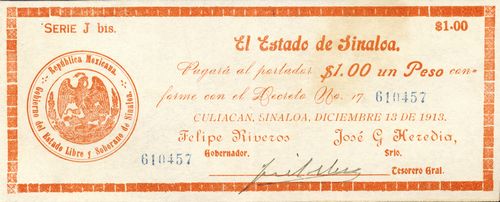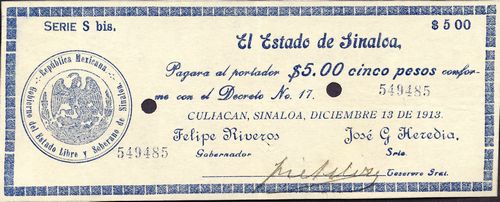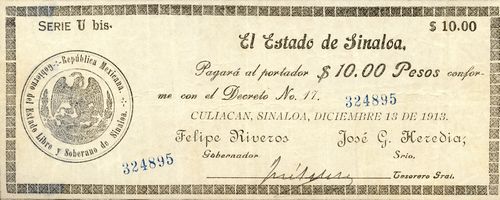Felipe Riveros in Culiacán
Riveros still wanted to issue up to $1m and was seeking Carranza’s authority. On 28 October Carranza told Riveros that he had contacted a J. Webb, a printer in Los Angeles, and told him to come to Hermosillo, Sonora to discuss the proposition. Carranza wanted to avoid any notes being seized by the American authorities, which had happened with the Monclova issueAIF, RM/V, 1-015, Consecutivas cartas enviados por Venustiano Carranza .
Decree núm. 17
On 14 November 1913 the rebels had taken the state capital, Culiacán. With Carranza’s blessing, decree núm. 17[text neeeded], of 13 December, authorized another $500,000 in 25 series (Series A bis to T bis, W, U bis, V bis, X bis, Y bis) each composed of 2,500 $1, 2,500 $5 and 500 $10 notes.



These notes had the new location, Culiacán, and, alongside Riveros as Governor and Meza as Treasurer, José G. Heredia, as secretary.
| Series | from | to | total number |
total value |
||
| $1 | A bis | 2,500 | 2,500 | |||
| B bis | 2,500 | 2,500 | ||||
| C bis | 2,500 | 2,500 | ||||
| D bis | 2,500 | 2,500 | ||||
| E bis | 2,500 | 2,500 | ||||
| F bis | 2,500 | 2,500 | includes numbers 599486 to 600327CNBanxico #6149 | |||
| G bis | 2,500 | 2,500 | ||||
| H bis | 2,500 | 2,500 | includes number 604996CNBanxico #6148 | |||
| I bis | 2,500 | 2,500 | ||||
| J bis | 2,500 | 2,500 | includes number 609959CNBanxico #12030 to 610457 | |||
| K bis | 2,500 | 2,500 | ||||
| L bis | 2,500 | 2,500 | ||||
| M bis | 2,500 | 2,500 | ||||
| N bis | 2,500 | 2,500 | ||||
| O bis | 2,500 | 2,500 | ||||
| P bis | 2,500 | 2,500 | ||||
| Q bis | 2,500 | 2,500 | ||||
| R bis | 2,500 | 2,500 | ||||
| S bis | 2,500 | 2,500 | ||||
| T bis | 2,500 | 2,500 | ||||
| W | 2,500 | 2,500 | ||||
| U bis | 2,500 | 2,500 | ||||
| V bis | 2,500 | 2,500 | ||||
| X bis | 2,500 | 2,500 | ||||
| Y bis | 2,500 | 2,500 | ||||
| $5 | A bis | 2,500 | 12,500 | |||
| B bis | 2,500 | 12,500 | ||||
| C bis | 2,500 | 12,500 | ||||
| D bis | 2,500 | 12,500 | includes numbers 336286CNBanxico #6152 to 336994CNBanxico #6151 | |||
| E bis | 2,500 | 12,500 | ||||
| F bis | 2,500 | 12,500 | ||||
| G bis | 2,500 | 12,500 | includes number 318895CNBanxico #6155 | |||
| H bis | 2,500 | 12,500 | ||||
| I bis | 2,500 | 12,500 | ||||
| J bis | 2,500 | 12,500 | includes number 371834CNBanxico #12032 | |||
| K bis | 2,500 | 12,500 | ||||
| L bis | 2,500 | 12,500 | ||||
| M bis | 2,500 | 12,500 | includes number 380187CNBanxico #12031 | |||
| N bis | 2,500 | 12,500 | includes number 382101CNBanxico #6156 | |||
| O bis | 2,500 | 12,500 | includes number 385723CNBanxico #6153 | |||
| P bis | 2,500 | 12,500 | ||||
| Q bis | 2,500 | 12,500 | ||||
| R bis | 2,500 | 12,500 | includes number 548369CNBanxico #6150 | |||
| S bis | 2,500 | 12,500 | includes number 549485 | |||
| T bis | 2,500 | 12,500 | ||||
| W | 2,500 | 12,500 | ||||
| U bis | 2,500 | 12,500 | ||||
| V bis | 2,500 | 12,500 | ||||
| X bis | 2,500 | 12,500 | ||||
| Y bis | 2,500 | 12,500 | includes numbers 564652 to 568870CNBanxico #6154 | |||
| $10 | A bis | 500 | 5,000 | |||
| B bis | 500 | 5,000 | includes number 313496 | |||
| C bis | 500 | 5,000 | ||||
| D bis | 500 | 5,000 | ||||
| E bis | 500 | 5,000 | includes number 548369CNBanxico #6150 | |||
| F bis | 500 | 5,000 | ||||
| G bis | 500 | 5,000 | ||||
| H bis | 500 | 5,000 | ||||
| I bis | 500 | 5,000 | ||||
| J bis | 500 | 5,000 | ||||
| L bis | 500 | 5,000 | includes number 320459CNBanxico #12033 | |||
| M bis | 500 | 5,000 | ||||
| N bis | 500 | 5,000 | ||||
| O bis | 500 | 5,000 | ||||
| P bis | 500 | 5,000 | ||||
| Q bis | 500 | 5,000 | ||||
| R bis | 500 | 5,000 | ||||
| S bis | 500 | 5,000 | ||||
| T bis | 500 | 5,000 | ||||
| W | 500 | 5,000 | ||||
| U bis | 500 | 5,000 | includes numbers 324895 to 325158CNBanxico #12034 | |||
| V bis | 500 | 5,000 | includes numbers 325343CNBanxico #6157 to 325769 | |||
| X bis | 500 | 5,000 | includes number 326133CNBanxico #6158 | |||
| Y bis | 500 | 5,000 | ||||
| $500,000 |
On 20 January 1914 the Correo de la Tarde in Huertista-held Mazatlán reported that the revolutionaries in Tepic had ordered the supression of these notes, nicknamed ‘yoyomos’, in favour of pesos produced in El Rosario and the Monclova issueEl Correo de la Tarde, Año XXIX, Núm. 9370, 20 January 1914. However, on 28 February Carranza, from his headquarters at Nogales, Sonora, made the issues that had been issued, with his approval, by the Constitutionalist governments in Sonora, Chihuahua, Sinaloa, Durango, Nuevo León and Tamaulipas forced circulation throughout the territory dominated by the Constitutionalist government, and the Sinaloa notes were accepted, though with difficulty, in neighbouring states.
After the Carranza-Villa split, the Riveros’ issues continued to be listed by the Villistas among the notes of forced circulation, but were disowned by the Carrancistas and Carranza never made any provision for any sort of retirement, despite the fact that he had given his blessing to the earlier issues.
On 5 December 1914 the Conventionist President, General Gutiérrez, confirmed Riveros as governor. In late December Riveros visited Guitérrez and Villa in Mexico CityVida Nueva, 22 December 1914: El Monitor, 22 December 1914 to discuss the campaign. On 30 December Riveros was allotted $300,000 for the expenses of his brigade (para haberes de tropa y oficialidad de la Brigada Riveros)AHSDN, Archivo de Cancelados ac, exp. Gral. Felipe Riveros, xi/111/3-1439, f. 3. On 2 January 1915 the Secretario de Guerra y Marina, General José Isabel Robles, notified Riveros that he had been named Comandante Militar with full powers, and that, if the circumstances demanded, he was authorised to issue paper currencyAHSDN, Archivo de Cancelados ac, exp. Gral. Felipe Riveros, xi/111/3-1439, f. 8.
Withdrawal
At the end of December 1915 Manuel M. Díeguez, Jefe de Operaciones en el Noroeste, from Esperanza, Sonora, told the Jefe de Hacienda in Mazatlán, Alejandro Duhagón, that since the circulation of Durango and Riveros notes was contrary to Carranza’s decree and another from his own Cuartel General he had decided to set a period of fifteen days from 1 January for holders to hand them in to the Jefatura and its dependencies in return for a certificate of deposit. Thereafter they would be considered null and voidPeriódico Oficial, Sinaloa, Tomo VII, Núm. 3, 6 January 1916.
